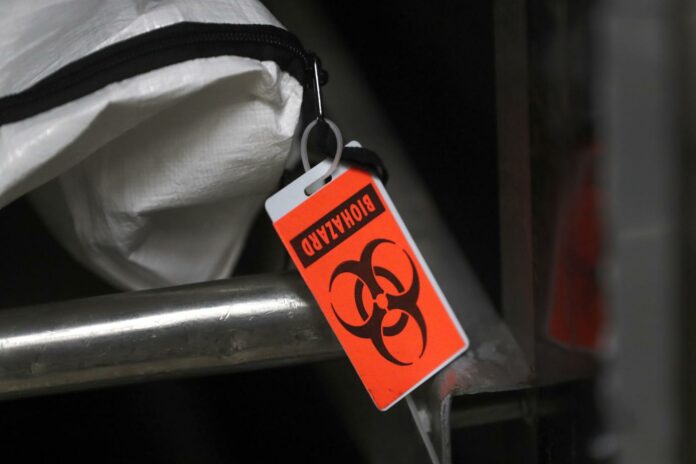
Charles Rex Arbogast
BY Erin Prater
June 1, 2020
A coronavirus spike in Colorado this summer could be larger than the one seen in April and overwhelm hospital capacity, the dean of the Colorado School of Public Health said Monday.
An increase in virus cases is expected in July, with a spike in September, according to three models Dr. Jon Samet, dean of the Colorado School of Public Health, presented during a morning news media call.
As restrictions loosen throughout the state and the weather warms, the hours that Coloradans spend at home are decreasing. While hospitalizations are declining, the rate of decline is slowing, which is “what we would expect as the distancing measures are laxed somewhat,” he said.
The reproductive number — or the average number of secondary cases of coronavirus stemming from one initial case, also known as the R0 value — began to increase around May 8, about a week and a half after the end of Gov. Jared Polis’ “stay at home” order, Samet said. The number remains slightly under one, Samet said, explaining that when the number exceeds one, infections are expected to increase. The number is expected to increase with relaxed restrictions, but it’s important that the number increases in a “controlled way,” he said.
Since the virus was first identified in Colorado earlier this year, 1,181 people have died from COVID-19, the disease it causes, state data show. The Institute for Health Metrics and Evaluation at the University of Washington in Seattle projects that number will nearly triple, to 3,457, by early August.
Coloradans are believed to be practice ing social-distancing at about 65%, but Samet said he fears that number could soon drop to as low as 45%, which would lead to a surge in virus patients in excess of hospital capacity by mid-summer, even given increased mask-wearing and higher levels of social distancing by older adults, Samet said.
High levels of social distancing, at 60-65%, along with mask-wearing and contact-tracing, are needed to avoid exceeding hospital capacity, he said.
Recent protests throughout Colorado and the country in response to the death of an unarmed Minnesota black man, George Floyd, by police — at which large crows and many maskless faces have been seen — had state officials expressing support for the ability to peacefully demonstrate but warned that “mass gatherings promote spread of the virus.”
Rally participants as well as law enforcement officials and members of the media at the protests should wear masks and keep a six-foot distance from each other, state health department executive director Jill Hunsaker Ryan said.
At any point in time, one in every 300 Coloradans is “actively infectious,” said Dr. Rachel Herlihy, an epidemiologist with the state health department, adding that officials will know in about two weeks whether the protests caused an increase in virus transmission. The virus takes about two weeks after exposure to show symptoms.
Coronavirus cases in Colorado rose by more than 2,000 in the week that ended Saturday, but deaths Thursday and Friday were at their lowest since late March, according to data from the state health department. In the week that ended Friday, 36 Coloradans died from the disease, according to the data.
Colorado deaths on Friday, the last day of data made available by the state, were at one, and at one on Thursday as well. The one-day totals are the lowest since March 20, when the death total was also one.
In other news:
– An estimated 171,000 Coloradans have been infected with COVID-19, representing about 3% of the state population, Samet said.
– About 52% of asymptomatic infections — those who don’t show symptoms — are being detected, Herlihy said.
– Asymptomatic individuals with a known coronavirus contact should be tested about seven days after exposure, she said, adding that such individuals will need to quarantine for 14 days.

What We Believe
We are driven by our deep respect for our environment, and our passionate commitment to sustainable tourism and conservation. We believe in the right for everyone – from all backgrounds and cultures – to enjoy our natural world, and we believe that we must all do so responsibly. Learn More






